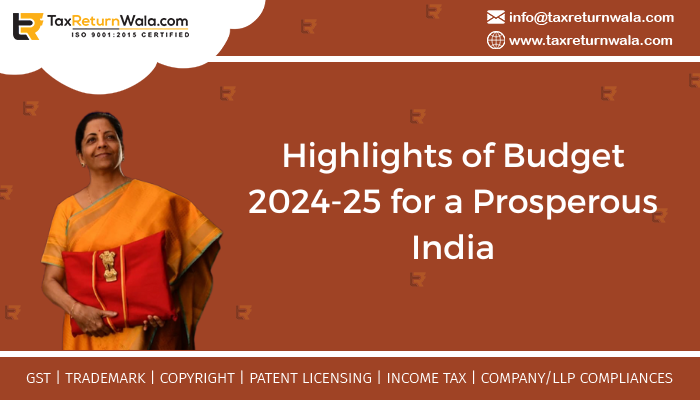Unlocking the Key Highlights of Budget 2024-25 for a Prosperous India
In the realm of finance, the eagerly awaited Union Budget is the compass that guides the financial course for the salaried class. On the 1st of February 2024, Finance Minister Nirmala Sitharaman presented the Interim Budget for the fiscal year 2024, keeping the suspense alive for the full budget presentation in July by the newly elected or re-elected government. The spotlight of this budget revolves around income tax slabs, with the Minister choosing to maintain the status quo for both new and old tax regimes.
New Regime Tax Slabs:
– No tax on income up to ₹3 lakh
– 5% tax on income between ₹3-6 lakh (with rebate under Section 87A)
– 10% tax on income between ₹6-9 lakh
(with rebate under Section 87A for income up to ₹7 lakh)
– 15% tax on income between ₹9-12 lakh
– 20% tax on income between ₹12-15 lakh
– 30% tax on income of ₹15 lakh and above
Noteworthy is the uniformity of tax rates across all categories – Individuals, Senior citizens, and Super senior citizens.
Old Regime Tax Slabs:
– Income up to ₹2.5 lakh is exempt from taxation
– 5% tax on income between ₹2.5 to ₹5 lakh
– 20% tax on personal income from ₹5 lakh to ₹10 lakh
– 30% tax on personal income above ₹10 lakh
In a significant move, the government has decided to withdraw outstanding direct tax demands up to Rs. 25,000 for the period up to the financial year 2009-10, and up to Rs. 10,000 for financial years 2010-11 to 2014-15. This decision is expected to benefit approximately 1 crore taxpayers.
For the startup ecosystem, there is a sigh of relief as the Centre has extended certain tax benefits to startups and investments made by sovereign wealth and pension funds. Additionally, tax exemption on specific incomes of International Financial Services Centre (IFSC) units has been extended until March 2025.
Interim Budget Overview:
Finance Minister Nirmala Sitharaman presented the Union Budget 2024 as an interim one, given its timing just before the Lok Sabha Elections. The full-fledged budget will be presented post-election by the incoming government. Reflecting on the challenges faced in 2014, the Finance Minister outlined the structural reforms and pro-people measures that led to job creation and entrepreneurship growth, instilling a sense of purpose and hope in the country.
Emphasizing the government’s vision for a developed India by 2047, Finance Minister Sitharaman reiterated the focus on ‘sabka sath, sabka vikas’ (development for all). The key target groups for development are the poor, women, youth, and farmers.
Sustainable Development:
- Rooftop Solarisation: Aiming to provide 1 crore households with 300 units of free electricity per month.
- Commitment to ‘Net Zero’ by 2070: Includes setting up coal gasification and liquefaction capacity, phased mandatory blending of CNG, PNG, and compressed biogas, financial assistance for biomass aggregation machinery, adoption of e-buses for public transport, and support for manufacturing and charging of e-vehicles.
Infrastructure and Investment:
- PM Gati Shakti: Implementation of 3 major railway corridor programs.
- Airport Development: Expansion of existing airports and comprehensive development of new airports under the UDAN scheme.
- FDI Focus: Encouraging bilateral trade treaties to boost Foreign Direct Investment (FDI).
Inclusive Development:
- Housing: Targeting an additional 2 crore houses in the next 5 years under Pradhan Mantri Awas Yojana (Gramin). Launching a Housing for Middle-Class scheme to promote middle-class home ownership.
- Tourism: Providing long-term interest-free loans to states for development projects in port connectivity, tourism infrastructure, and amenities, including projects in islands like Lakshadweep.
- Health: Initiatives include cervical cancer vaccination for girls, acceleration of Saksham Anganwadi and Poshan 2.0 for improved nutrition delivery, and extension of health cover under the Ayushman Bharat scheme to all ASHA, Anganwadi workers, and helpers.
Technology:
A corpus of ₹1 lakh crore will be established with a 50-year interest-free loan to provide long-term financing with lower interest rates. New technology will be introduced to strengthen deep tech for defense purposes.
Agriculture and Food Processing:
- Expansion of Nano-DAP application in all agro-climatic zones.
- Formulation of a comprehensive program for dairy development.
- Stepping up the implementation of Pradhan Mantri Matsaya Sampada Yojana to enhance aquaculture productivity, double exports, and generate more employment opportunities. Set up of 5 Integrated Aquaparks.
Taxation:
– Retention of the same tax rates for direct and indirect taxes, including import duties.
– Corporate taxes: 22% for existing domestic companies, 15% for certain new manufacturing companies.
– No tax liability for taxpayers with income up to ₹7 lakh under the new tax regime.
– Extension of tax benefits for startups and investments made by sovereign wealth and pension funds until March 2025.
– Withdrawal of outstanding direct tax demands up to ₹25,000 for the period up to financial year 2009-10 and up to ₹10,000 for financial years 2010-11 to 2014-15, benefiting approximately 1 crore taxpayers.
The Union Budget 2024-25 is a strategic roadmap for India’s progress, addressing key challenges and fostering development across various sectors. With a focus on sustainable practices, infrastructure, inclusive development, technology, and agriculture, the government is committed to holistic growth. The continuity of tax rates and incentives for startups aims to stimulate economic activity. Overall, this budget outlines a comprehensive approach to meet both immediate needs and long-term sustainability, paving the way for a prosperous India.
For any queries or clarifications, feel free to reach
out to us at info@taxreturnwala.com.


